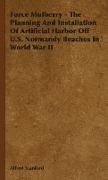- Start
- Force Mulberry - The Planning and Installation of Artificial Harbor Off U.S. Normandy Beaches in World War II
Force Mulberry - The Planning and Installation of Artificial Harbor Off U.S. Normandy Beaches in World War II
Angebote / Angebote:
FORCE MULBERRY- The Planning and Installation of the Artificial Harbor off U. S. Normandy Beaches in World War II 1951 By ALFRED STANFORD. INTRODUCTION: IN THIS book Commander Stanford has made a very im portant contribution to the history of World War II, and in the writing of it he has recaptured the tense excitement, almost desperation, of planning and executing the landings in Normandy. The Mulberries, the two artificial harbors established immediately after the initial landings, were ab solutely essential for the success of Operation Overlord. For, as we found out in World War II, the most difficult thing in an amphibious operation is not to establish the initial beachhead that can almost always be done if sufficient force is employed and tactical surprise is obtained but to sustain and reinforce the ground troops against the beachhead, and attain the objective. Massive as was the Anglo-American assault on the Nor mandy beaches, it had to be followed up immediately by even greater increments of men, armor, vehicles and sup plies to make it succeed. There was no possibility of getting all this ashore over wave-lashed beaches where spring tides rose twenty-one feet. One or more ports were essential to maintain an even flow of men and materiel. But all the French ports, notably the nearest ones at Cherbourg and Le Havre, were so strongly held by the enemy that the cap ture of one would employ forces badly needed elsewhere for at least six weeks, during which the Germans would be unexpectedly weak or very stupid if they did not succeed in rubbing out the initial beachhead. The only possible way out of this dilemma was the ap parently impossible task of providing sheltered water off the beaches within a matter of three days. Since speed was of the essence, all elements of the artificial harbors would have to be constructed in England, towed across the Channel under danger of wind, weather and enemy air attack, and sited under fire. Commander Stanford, who was Deputy Commander Mul berry A under the hard-driving Capt. A. Dayton Clark, par ticipated in the planning, the training and the execution. He has told a fascinating story of all three phases. The need of secrecy was so paramount that very few men among the detailed planners could know what the whole thing was about. The Phoenixes enormous concrete caissons as big as a five-story apartment house the Whales pontoon-sup ported ramps capable of handling heavy armor and the Gooseberries vessels to be sunk as an outer line of protec tionhad to be built or procured at a dozen different ports of the United Kingdom. Men had to be specially trained to operate them, tugs procured to tow them, combatant ships found to escort them, salvage or towboat experts engaged who were capable of solving these new and unprecedented problems. There were difficulties due to Anglo-American rivalry, to the indifference of top commanders to subjects they did not quite understand, to the scarcity of labor and materials, to the crowded ports and overcharged communi cation channels. The American Mulberry A was assembled off Omaha Beach on D-plus-8-day 14 June 1944, twenty-four hours ahead of the expected time. That in itself was a marvelous achievement, and it functioned so smoothly that on 14-18 June inclusive an average of over 8, 500 tons of cargo poured ashore over it daily. Then, on 20 June, there blew up the strongest summer gale known in the English Channel for forty years. At the end of two days 1 bashing by wind, waves, and vessels that dragged anchors and pounded against it, Mulberry A looked like a complete wreck...
Folgt in ca. 15 Arbeitstagen




